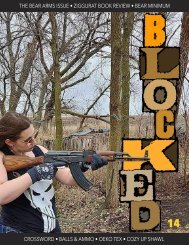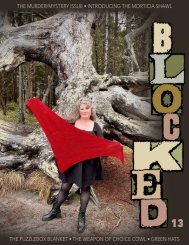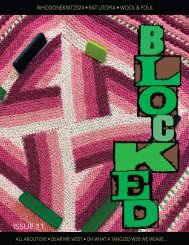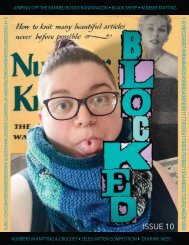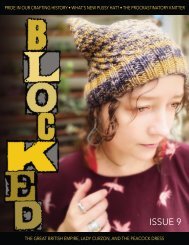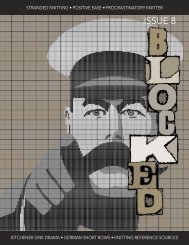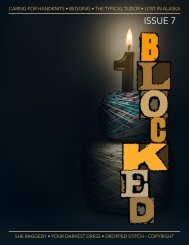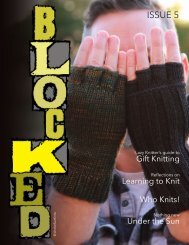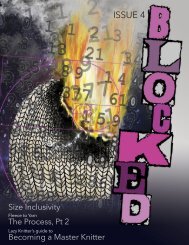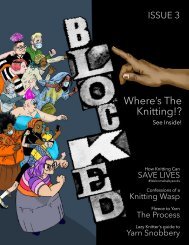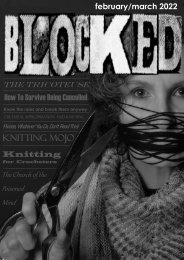Create successful ePaper yourself
Turn your PDF publications into a flip-book with our unique Google optimized e-Paper software.
Book Reviews... Continued...<br />
Knitting Workshop (Zimmermann, 1981) is a paperback<br />
book, with color photos, and detailed illustrations that<br />
contains four sections. The first section introduces casting<br />
on, knitting, gauge, increasing, colorwork, decreasing,<br />
and blocking. The second section uses EPS to design a<br />
seamless yoke and a drop-shoulder sweater. The third<br />
section reviews seven seamless shoulder shaping, Zimmerman’s<br />
love of garter stitch, lace<br />
shawls, and Aran, Guernsey, and<br />
Fair Isle sweaters. The fourth section<br />
contains seven sweater patterns,<br />
a hat pattern, and a V-neck<br />
Fair Isle vest. Zimmermann’s famous<br />
Baby Surprise Jacket pattern is also<br />
included.<br />
The Sweater Workshop (Fee,<br />
2002), fits into this review as it is inspired<br />
by Elizabeth Zimmermann’s<br />
processes and is written to allow<br />
you to design your sweater, using<br />
your own yarn (including handspun),<br />
and gauge. The book is paperback<br />
with clear illustrations and color<br />
photography. The sweaters shown<br />
are from the 1980s, in terms of the<br />
color and yarn selections.<br />
Jacqueline Fee uses Elizabeth<br />
Zimmermann’s seamless raglan<br />
sweater as the base pattern with a<br />
few changes: a lowered neckline<br />
to create a true crew neck and<br />
slowing the raglan decreasing<br />
frequency which lengthens the<br />
yoke.<br />
The Sweater Workshop has five<br />
chapters, all leading to designing<br />
sweaters by the fourth chapter.<br />
The first chapter, “The Sweater<br />
Sampler,” provides a knitting exercise to help the knitter<br />
understand why, where, and when to use stitches, increases,<br />
decreases, and knit in the round, with lessons on<br />
the various stitches and techniques used as you complete<br />
the project. In addition, it has a three-page review of six<br />
raglan seamline decreases. To be honest, I know I will not<br />
complete the knitting exercise. New knitters may appreciate<br />
the knitting exercise and benefit from completing it.<br />
The second chapter, “Equip Yourself,” provides a basic<br />
review of fiber content, using handspun yarn, ply structure,<br />
and recommended notions. The chapter includes instructions<br />
on how to sew a circular needle case.<br />
The third chapter, “Unravel your Thinking,” provides an<br />
interesting review of the history of designing sweaters, including<br />
illustrations of the tools used to<br />
measure adults for sweater design and a review<br />
of gauge. If you are interested in the<br />
history of knitting, this chapter is for you!<br />
The fourth chapter, “Basic Sweater,” explains<br />
the basics of designing your sweater.<br />
It starts with how to measure your favorite<br />
fitting sweater, then provides in-depth instructions<br />
for knitting a basic crew neck, raglan<br />
sleeve, bottom-up sweater, with sleeves<br />
that join at the underarm. She includes a few<br />
extras, such opportunities to use short rows,<br />
adding a sweatshirt pocket, using crew neck<br />
shaping, a choice of six sleeve styles (ranging<br />
from fitted to even fuller fullest), and a<br />
gauge page. The gauge page is a<br />
worksheet to use your gauge and desired<br />
sweater measurements to determine<br />
the key number of stitches, from<br />
which you determine the stitch counts<br />
for the body and sleeves (built from<br />
Zimmermann’s EPS).<br />
The fifth chapter, “The Sweater Variations,”<br />
provides resources for sweater<br />
design inspiration, pattern selection,<br />
and knitting hints. The chapter includes<br />
adding in cables, lace, moss stitch,<br />
overall Aran cables, and color work designs.<br />
It also provides instructions for<br />
placket and crew neck options, and<br />
how to alter your pattern to a V-neck<br />
cardigan.<br />
While this book is fairly accessible to knitters who are<br />
new to knitting patterns, I think it is a good idea to have<br />
some understanding and exposure to knitting sweaters<br />
before trying Fee’s methods for designing a sweater. You<br />
can purchase this on Amazon: https://a.co/d/0UWneEC<br />
Continued on next page<br />
25





